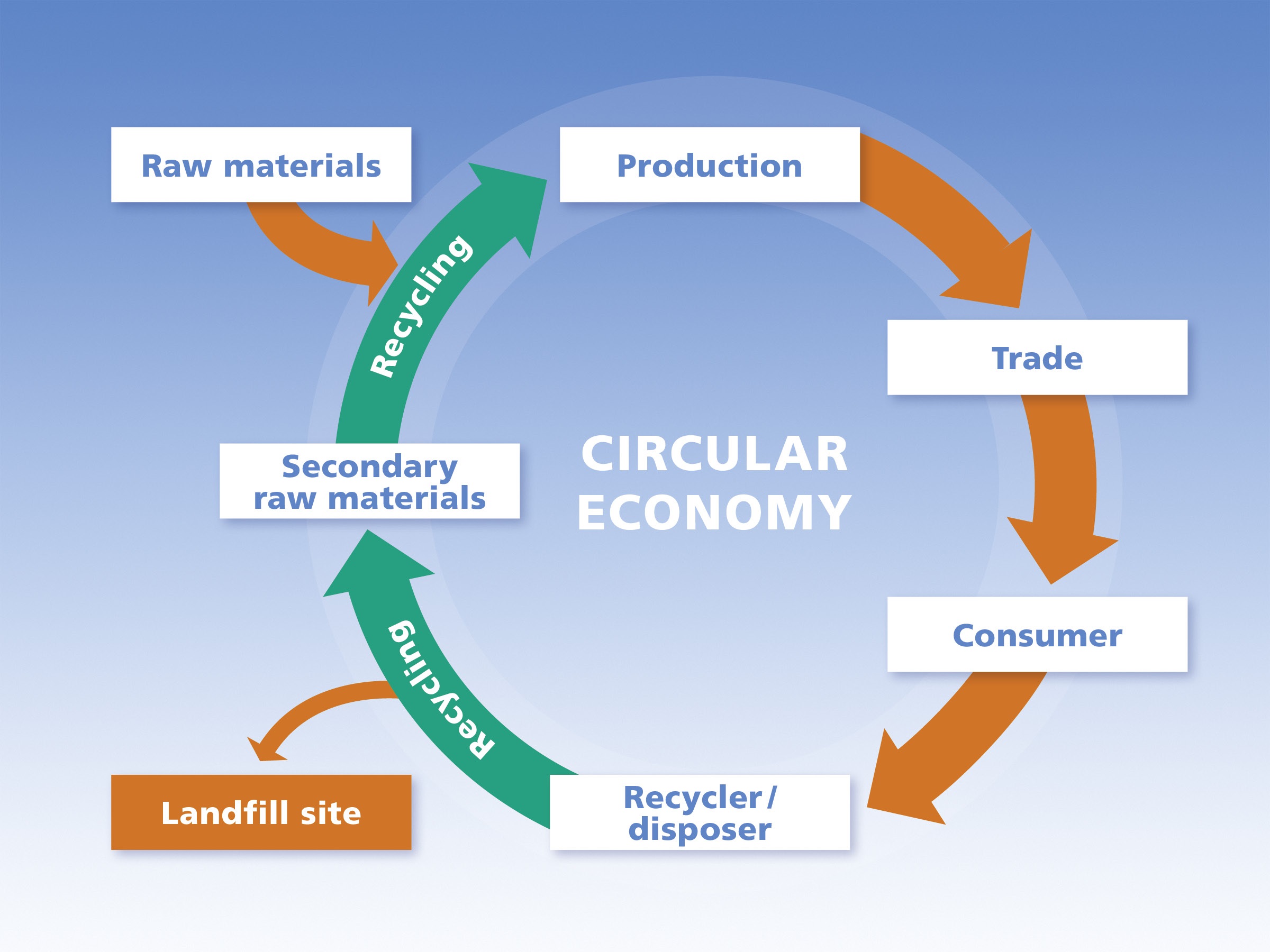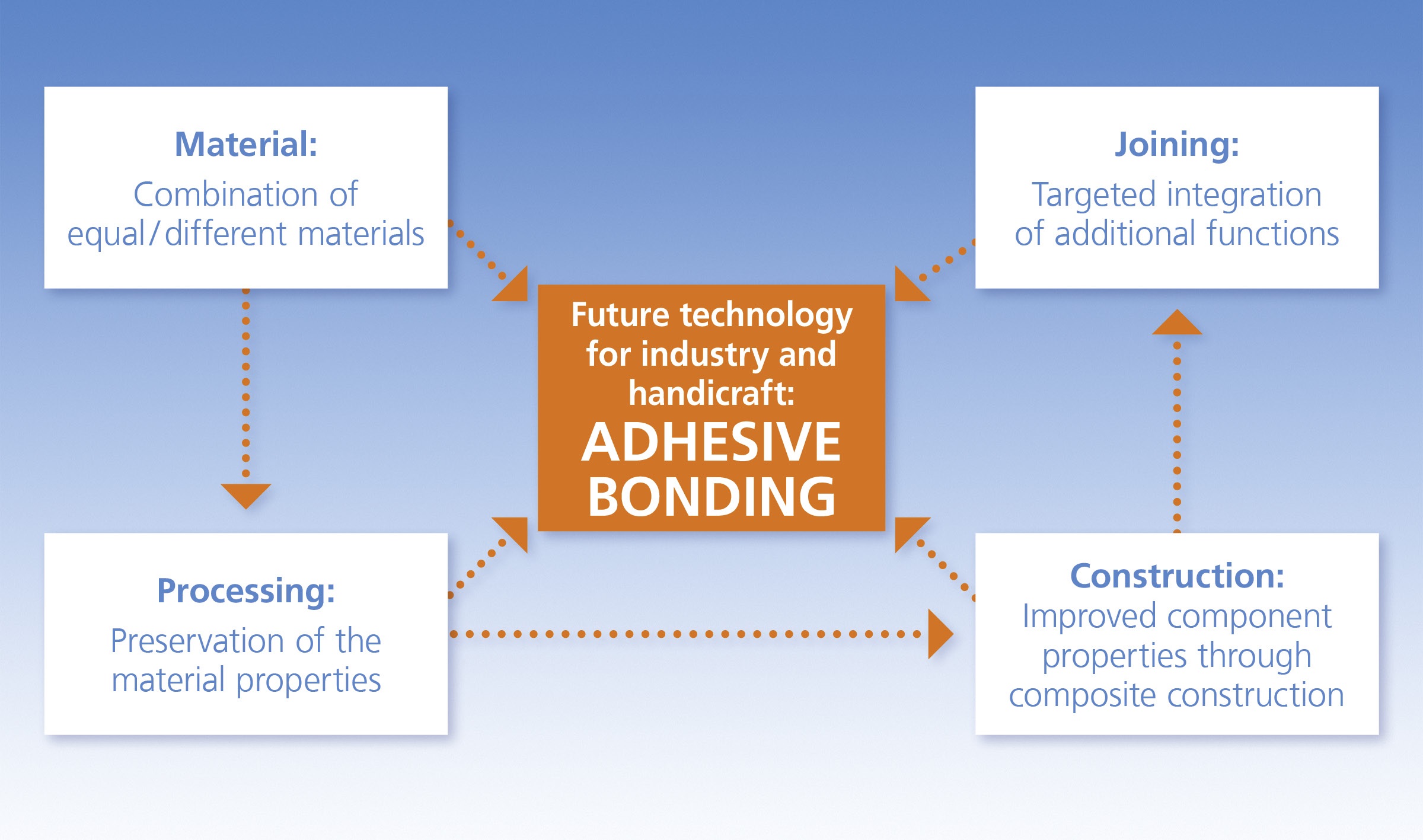Climate and environmental crisis are an existential threat to the world - and seem to deteriorate with every year. The central question is: How can we encounter these challenges on a long term? At the moment, the most auspicious approach is the European Green Deal – a concept by the European Comission – aiming to transform Europe into the first climate-neutral continent. The circular economy strategy is part of the Green Deal – and adhesive bonding technology can contribute an essential part to the circular economy. Against this background, the latest study by Fraunhofer IFAM »Circular Economy and Adhesive Bonding Technology« examines the role of adhesive bonding technology for meeting requirements in the context of circular economy and eco-design.
Overcoming the challenges of climate change and environmental degradation: How circular economy, life cycle assessments and adhesive bonding technology fit together


In the context of the Green Deal: the relation of circular economy and adhesive bonding technology
The circular economy strategy is part of the Green Deal, as it represents a regenerative and renewable system in which the production of waste and emissions as well as the waste of energy are minimised. The aim is to accelerate the transition to a circular economy along their value chain. In this context, materials are an important factor for meeting future product requirement profiles. Many current studies demonstrate the dependence of a large number of technical innovations on the respective material – directly or indirectly. Consequently, the variety of special materials for the manufacture of products is increasing permanently and multi-component materials will will be of great value.
At this point adhesive bonding technology comes into play. The special feature of this technology is that all materials can be jointed together with long-term stability - without depreciating the special material properties. Thus, adhesive bonding opens up unique neconstruction methods. Meanwhile, it is used in almost every industrial, handicraft or household-related area. The technology already has long been an integral part of innovative technology development and leads to an indirectly generated value of approximately 450 billion euros annually in Germany (as of 2018).
Life cycle assessments and adhesively bonded products
Few people know that adhesive bonding technology supports or enables life cycle assessment (LCA) and thus has positive effects on it. The effectiveness of the circular economy results from the fact that adhesively bonded joints can be used safely and then released again in a controlled manner. Thus, adhesive bonding technology supports the »Ecodesign Directive«, which takes a holistic view of a product life cycle with a focus on greenhouse gas emissions. Currently, the most comprehensive assessment method for environmental impacts is the life cycle assessment (LCA/ISO 14040 - 44) which enables the holistic consideration of adhesively bonded products with regard to ecological improvements. Industrial adhesive development has the potential to develop and offer technical suitable solutions as well as to meet new industry-specific requirements. The Fraunhofer IFAM has included two advanced training courses regarding LCA: The course DVS©/EWF- European Adhesive Engineer – EAE focuses on adhesive bonding as an 'enabler' on lightweight construction and the course Composite Engineer focuses on fiber-reinforced materials.
Why circular economy and life cycle assessment complete each other
Contrary to popular belief, adhesive bonding technology is neither contradictory with eco-design, nor with maintenance and repair or resource efficiency. Here is a short overview why:
1. Adhesive bonding technology and eco-design
First of all, seperating materials provides the basis for recycling, dismantling and repair. The detachment of an adhesively bonded joint is caused by at least one external trigger that does not occur in the normal use of the adhesively bonded joint and therefore does not affect the safe use of the adhesively bonded product.
2. Adhesive bonding technology and repair
Secondly, adhesive bonding is one of the most frequently used joining methods in the repair sector. Since objects of daily use can be used for longer, adhesive bonding technology contributes to the conservation of resources.
3. Adhesive bonding technology and recycling
Thirdly, it is important to consider debonding progresses already in the product design. Generally, a combination of local heat and mechanical loading is used to debond products. In case of a very heterogeneous product-mixture, the separation of the materials will only be possible after shredding. The adhesives remain on the separated materials, which is not a problem with materials like metal or glass. In the case of plastics, adhesives may lead to a loss of quality, whereas this is no problem in the case of heterogeneous product mixtures. Successful examples are the recycling of cars, mobile phones and soft packages.
4. Adhesive bonding technology and resource efficiency
Finally it comes to resource efficiency. Whether in regard to alternative energy sources (sealing of solar cells, joining of rotor blades in wind turbines), electromobility (construction of magnetic cores for electric motors from electro-packaging sheets, sealing of battery cells, thermal management of batteries with thermally conductive adhesives) or fuel cells (hermetic sealing, joining of bipolar plates): These processes are just not viable without adhesive bonding and sealing. In addition, the technology can increase the longevity of products – for example by preventing contact corrosion in metal bonding - and extend the products ageing resistance - for example through surface pretreatment to increase adhesion strength.
Resource efficiency and recycling: strategies in the field of adhesives and adhesive bonding technology
In the future, adhesive bonding technology will be a key to ensure that products can be repaired and recycled – but first of all it should be mentioned: Even the 'adhesive' itself can contribute to resource effciency. Recyclates are for example, suitable raw materials for adhesives. Beyond, bio-based adhesives are already being used in certain mass applications, even though their applicability is still limited.
Coming to the strategies in the field of adhesive bonding technology themselves, disassembly processes of adhesively bonded products for raw material recovery or repair will be milestones in the development process and product testing. Regarding a high number of variants, small dimensions and high quantities, shredding can be a variant of the disassembly process, which enables sorting by material type. Detaching by heat input is an instrument of dismantling adhesively bonded products - both in combination with mechanical detaching and independently.
Additionaly, adhesive bonding technology is an 'enabler' of lightweight construction, which has the advantage that is enables material savings and increased resource effciency in all phases of the product life cycle. There are two reasons why: Firstly, adhesive bonding contributes to constructive lightweight construction through adhesive bonding technology realisation of targeted structures. Secondly, by joining different materials that are used according to the specific requirements in the component, adhesive bonding in multi-material construction can make material lightweight construction feasible.
In addition to the lightweight construction potential, the design of a product consisting of several components that can be separated from each other again in the so-called differential construction method has further advantages in terms of reparability: Should an element of the product be damaged during the product use phase, it can be replaced without supplanting the entire product. Even minor design adjustments can be made in the existing process chain without having to create a completely new product line.
Adhesive bonding as the leading joining technology of today
What is certain is that whether in production, in application, in repair or in the disposal of adhesively bonded joints: adhesive technology has the potential to meet the economic, ecological and social requirements with technical innovations. The view 'from the material to the safe product' combines the aspects of safety and long-term stability with the requirements of circular economy and eco-balance effectiveness in the sense of sustainability of products. Additionally, adhesive bonding technology, the circular economy and life cycle assessment are by no way contradictory - they complement each other. Therefore, adhesive bonding technology not only has the necessary technological and ecological performance capacity, but also the potential to become the leading joining technology of the 21st century.